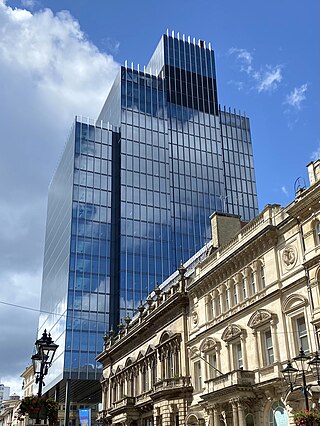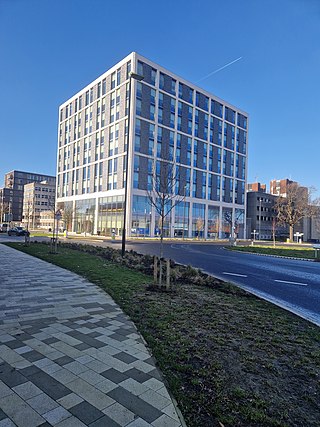
Birmingham Central Library was the main public library in Birmingham, England, from 1974 until 2013, replacing a library opened in 1865 and rebuilt in 1882. For a time the largest non-national library in Europe, it closed on 29 June 2013 and was replaced by the Library of Birmingham. The building was demolished in 2016, after 41 years, as part of the redevelopment of Paradise Circus by Argent Group. Designed by architect John Madin in the brutalist style, the library was part of an ambitious development project by Birmingham City Council to create a civic centre on its new Inner Ring Road system; however, for economic reasons significant parts of the master plan were not completed, and quality was reduced on materials as an economic measure. Two previous libraries occupied the adjacent site before Madin's library opened in 1974. The previous library, designed by John Henry Chamberlain, opened in 1883 and featured a tall clerestoried reading room. It was demolished in 1974 after the new library had opened.
Brutalist architecture is an architectural style that emerged during the 1950s in the United Kingdom, among the reconstruction projects of the post-war era. Brutalist buildings are characterised by minimalist constructions that showcase the bare building materials and structural elements over decorative design. The style commonly makes use of exposed, unpainted concrete or brick, angular geometric shapes and a predominantly monochrome colour palette; other materials, such as steel, timber, and glass, are also featured.

103 Colmore Row is a 108-metre tall, 26-storey commercial office skyscraper located on Colmore Row, Birmingham, England. Completed in 2021, this building replaced the former NatWest Tower designed by John Madin and completed in 1975. In 2008, a plan by then owners British Land to demolish Natwest Tower and replace it with a taller modern equivalent was approved. This plan never progressed and in 2015 the building passed to the developer Sterling Property Ventures, who successfully applied to have the building demolished. Construction of the new tower began in June 2019 and completed in 2021.

Council House is a 13-storey office building on St Georges Terrace in Perth, Western Australia. Located beside Stirling Gardens and Government House in the city's central business district, the 49.8-metre (163 ft) building was designed by Howlett and Bailey Architects and opened by Queen Elizabeth II in 1963, after Perth hosted the 1962 British Empire and Commonwealth Games. For most of its history, it has served as the headquarters for the City of Perth.

South Norwood Library is a purpose-built public library in South Norwood, South London. Also known locally as 'Brutalist Library' it stands in the London Borough of Croydon and is part of the Croydon Libraries arm of the council. The site on the corner of Selhurst Road and Lawrence Road first had a library built in 1897, which was replaced by the current building in 1966.

St Martin's Church is in Front Street, Brampton, Cumbria, England. It is an active Anglican parish church in the deanery of Brampton, the archdeaconry of Carlisle and the diocese of Carlisle. It is recorded in the National Heritage List for England as a designated Grade I listed building and is the only church designed by the Pre-Raphaelite architect Philip Webb. The architectural historian Nikolaus Pevsner described it as "a very remarkable building".

St. George's Church is in St George's Square, Barrow-in-Furness, Cumbria, England. It is the oldest active Anglican parish church in the town. The church is in the deanery of Barrow, the archdeaconry of Westmorland and Furness, and the diocese of Carlisle. Its benefice is united with those of St Aidan, Newbarns, St Luke, Risedale, and St Perran, Roose, to form the South Barrow Team Ministry. The church is recorded in the National Heritage List for England as a designated Grade II listed building. It stands at the southeast extremity of the town.

St Mary the Virgin's Church is located on the Promenade, Walney Island, Barrow-in-Furness. Cumbria, England. It is an active Anglican parish church in the deanery of Barrow, the archdeaconry of Westmorland and Furness, and the diocese of Carlisle. The church is recorded in the National Heritage List for England as a designated Grade II listed building.

St Michael's Church is in the village of Pennington, Cumbria, England. It is an active Anglican parish church in the deanery of Furness, the archdeaconry of Westmorland and Furness, and the diocese of Carlisle. Its benefice is united with those of Holy Trinity, Bardsea, and St Peter, Lindal and Marton. The church is recorded in the National Heritage List for England as a designated Grade II listed building.

The Warringah Civic Centre is a landmark civic building in Dee Why, a suburb of Sydney. It stands in the centre of Dee Why, along Pittwater Road. Designed in the Brutalist style by Colin Madigan and Christopher Kringas, it replaced the Warringah Shire Hall, a 1923 building also on Pittwater Road but in Brookvale opposite Brookvale Oval. The Civic Centre was the seat of Warringah Council from its opening on 1 September 1973 to 12 May 2016, when it became a seat of the new Northern Beaches Council.

Kensington Town Hall is a municipal building in Hornton Street, Kensington, London. It is the headquarters of Kensington and Chelsea London Borough Council.

Ernest Berry Webber, was an English architect, surveyor and town planner best known for his designs of municipal buildings, including those in Southampton in Hampshire, and Dagenham and Hammersmith, both in London.

The Ryde Civic Centre was a legacy 1960's modernist civic building in Ryde, Sydney, Australia. It stood as a local landmark in the centre of Ryde on land originally known as Hattons Flat, along Devlin Street. Designed in the Post-War International Style by Buckland & Druce architects, the Civic Centre was the seat of the City of Ryde from its opening in 1964, and was extended in 1972 to include the Civic Hall as an event and function space. It had been nominated multiple times for heritage listing but no serious investigation of its significance was ever undertaken. Possibly of State significance, it’s significance had been much debated. The demolition of the Parramatta Civic Centre was approved on the basis that the Ryde Civic Centre was a far better example. The Ryde Civic Centre was the only known surviving example of a mid 20th century Post War Civic Centre and Council administration building in New South Wales. The Civic Centre remained the council seat until 2016, when the main building was closed allegedly due to maintenance and safety issues. Demolition and redevelopment of the Ryde Civic Centre has been a hotly debated political issue for the Council. In 2019 Council lodged and approved a proposal to redevelop the Civic Centre site as the "New Heart of Ryde" designed by Plus Architecture, with Taylor Construction Group tendered as the builders in early 2020. In 2021, the Civic Centre, along with the Civic Hall was demolished to make way for the New Heart of Ryde.

Cumbria House is a municipal building in the Botchergate area of Carlisle, England. It is used by Cumberland Council.

County Hall is a municipal facility at Raikes Lane in Mold, Flintshire. It was the headquarters of the old Flintshire County Council from 1967 to 1974, the headquarters of Clwyd County Council from 1974 to 1996 and has been the headquarters of the new Flintshire County Council since 1996.

Ealing Town Hall is a municipal building in New Broadway, Ealing, London, England. It is a Grade II listed building.

The Old Town Hall is a municipal building in the Market Place, Carlisle, England. It is a Grade I listed building.

Sunderland Civic Centre was a municipal building in the Burdon Road in Sunderland, Tyne and Wear, England. It was the headquarters of Sunderland City Council until November 2021.

Crawley Town Hall is a municipal structure in The Boulevard, Crawley, West Sussex, England. It was completed in 2023 and serves as the headquarters of Crawley Borough Council.

Woking Civic Offices is a municipal building in Gloucester Walk, Woking, Surrey, England. It is in use as the headquarters of Woking Borough Council.





















